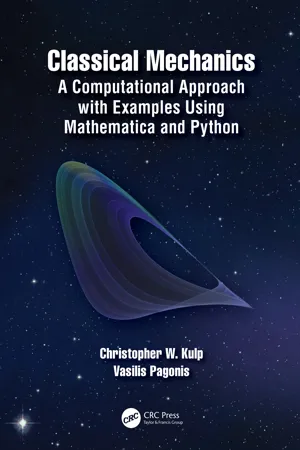
Classical Mechanics
A Computational Approach with Examples Using Mathematica and Python
- 440 pages
- English
- ePUB (mobile friendly)
- Available on iOS & Android
Classical Mechanics
A Computational Approach with Examples Using Mathematica and Python
About this book
Classical Mechanics: A Computational Approach with Examples using Python and Mathematica provides a unique, contemporary introduction to classical mechanics, with a focus on computational methods. In addition to providing clear and thorough coverage of key topics, this textbook includes integrated instructions and treatments of computation.
Full of pedagogy, it contains both analytical and computational example problems within the body of each chapter. The example problems teach readers both analytical methods and how to use computer algebra systems and computer programming to solve problems in classical mechanics. End-of-chapter problems allow students to hone their skills in problem solving with and without the use of a computer. The methods presented in this book can then be used by students when solving problems in other fields both within and outside of physics.
It is an ideal textbook for undergraduate students in physics, mathematics, and engineering studying classical mechanics.
Features:
- Gives readers the "big picture" of classical mechanics and the importance of computation in the solution of problems in physics
- Numerous example problems using both analytical and computational methods, as well as explanations as to how and why specific techniques were used
- Online resources containing specific example codes to help students learn computational methods and write their own algorithms
A solutions manual is available via the Routledge Instructor Hub and extra code is available via the Support Material tab
Frequently asked questions
- Essential is ideal for learners and professionals who enjoy exploring a wide range of subjects. Access the Essential Library with 800,000+ trusted titles and best-sellers across business, personal growth, and the humanities. Includes unlimited reading time and Standard Read Aloud voice.
- Complete: Perfect for advanced learners and researchers needing full, unrestricted access. Unlock 1.4M+ books across hundreds of subjects, including academic and specialized titles. The Complete Plan also includes advanced features like Premium Read Aloud and Research Assistant.
Please note we cannot support devices running on iOS 13 and Android 7 or earlier. Learn more about using the app.
Information
Table of contents
- Cover
- Half Title
- Title Page
- Copyright Page
- Dedication
- Contents
- Preface
- CHAPTER 1: The Foundations of Motion and Computation
- CHAPTER 2: Single-Particle Motion in One Dimension
- CHAPTER 3: Motion in Two and Three Dimensions
- CHAPTER 4: Momentum, Angular Momentum, and Multiparticle Systems
- CHAPTER 5: Energy
- CHAPTER 6: Harmonic Oscillations
- CHAPTER 7: The Calculus of Variations
- CHAPTER 8: Lagrangian and Hamiltonian Dynamics
- CHAPTER 9: Central Forces and Planetary Motion
- CHAPTER 10: Motion in Noninertial Reference Frames
- CHAPTER 11: Rigid Body Motion
- CHAPTER 12: Coupled Oscillations
- CHAPTER 13: Nonlinear Systems
- Bibliography
- Index